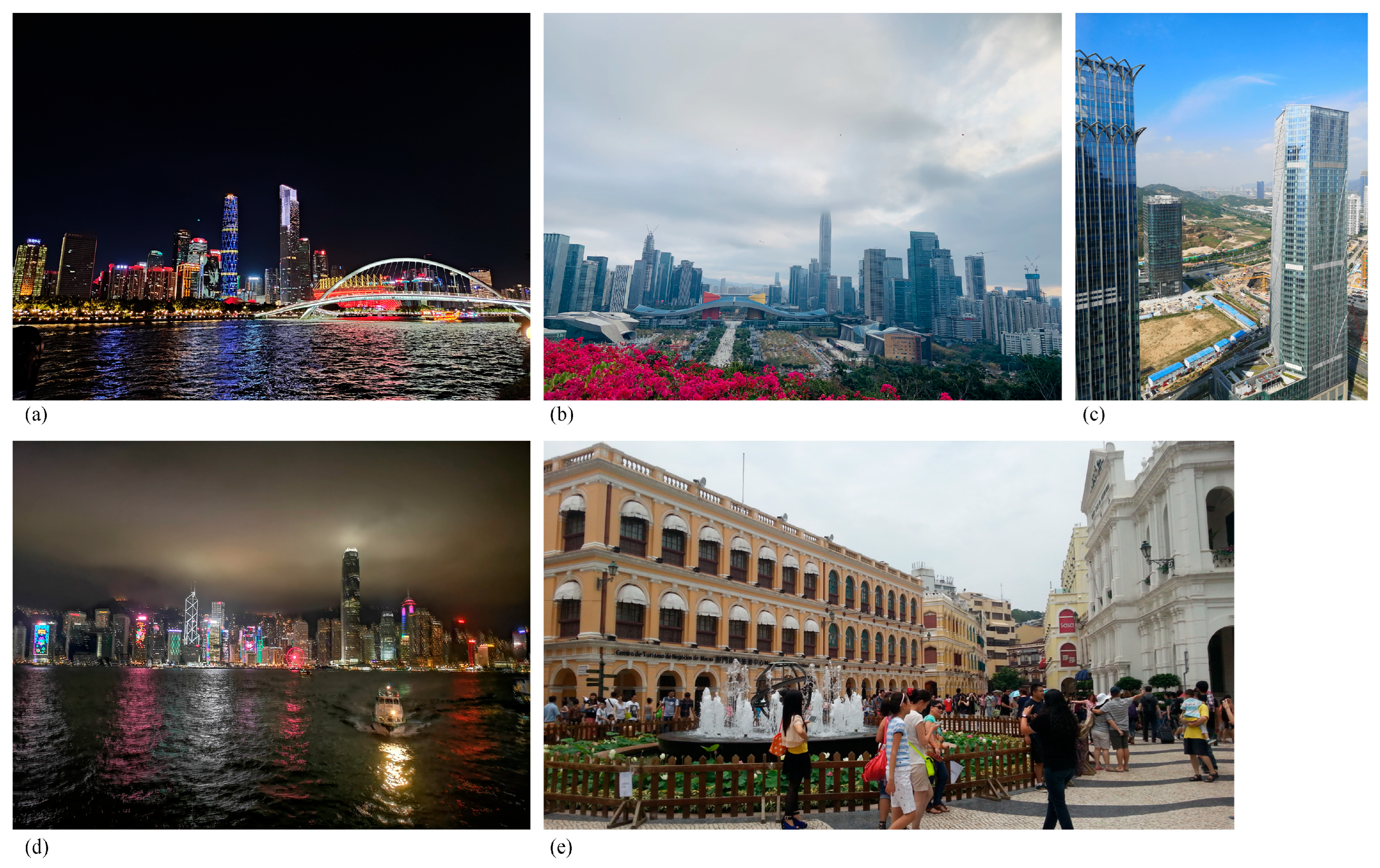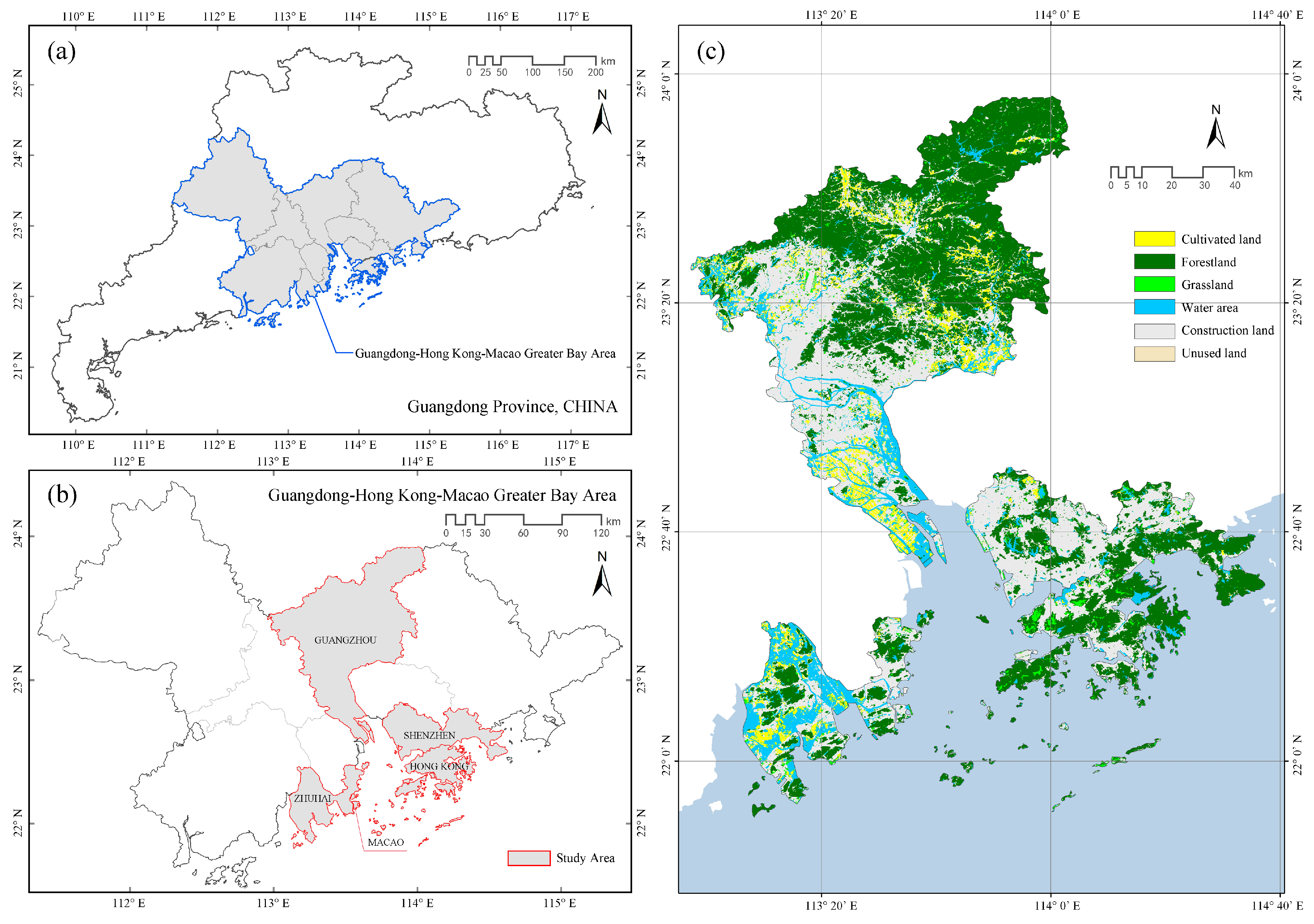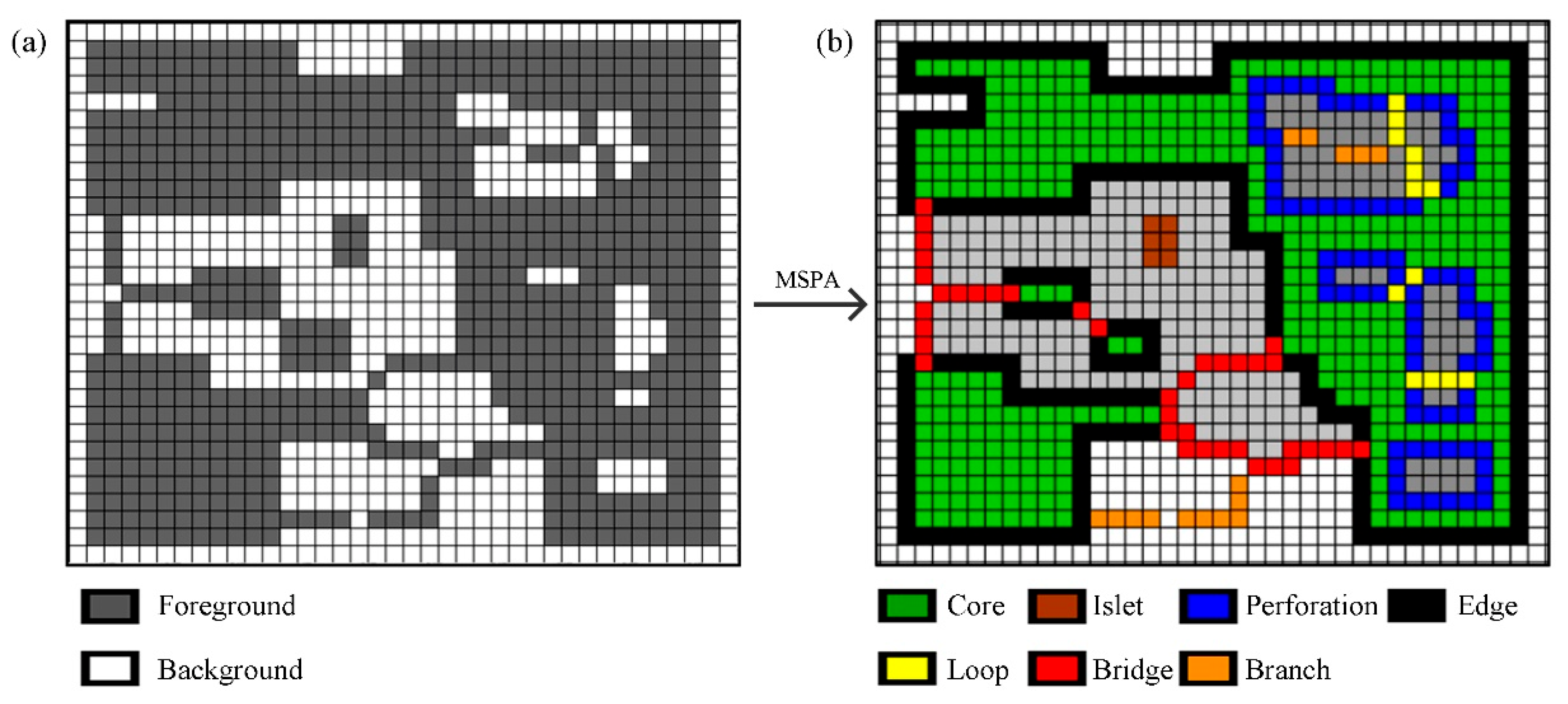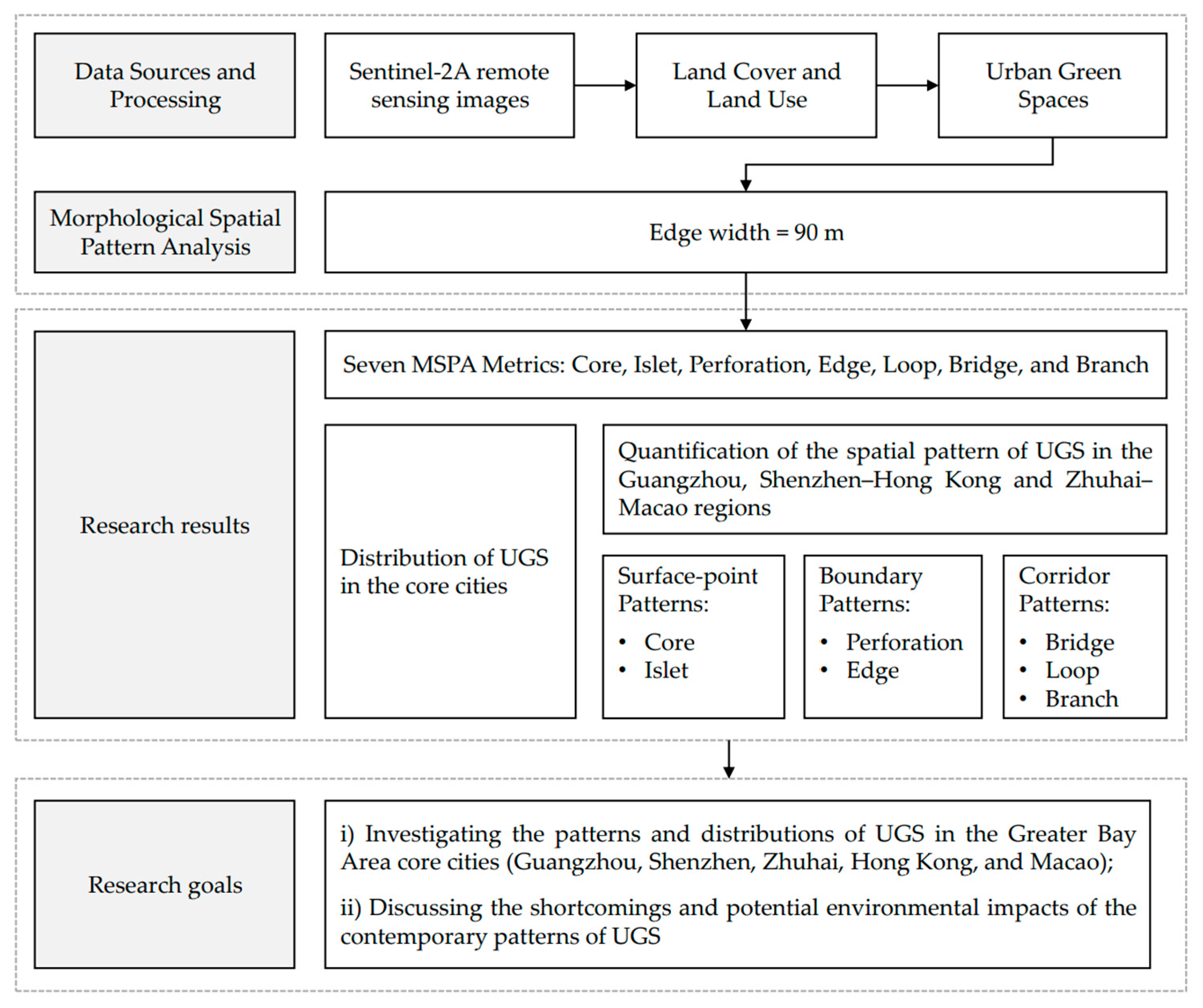Urban Green Space Pattern in Core Cities of the Greater Bay Area Based on Morphological Spatial Pattern Analysis
Abstract
:1. Introduction
2. Materials and Methods
2.1. Study Area
2.2. Data Sources and Processing
2.3. Morphological Spatial Pattern Analysis
3. Results
3.1. Distribution of UGSs in the Core Cities of the Guangdong–Hong Kong–Macao Greater Bay Area
3.2. Analysis of the Spatial Pattern of UGSs in the Guangzhou, Shenzhen–Hong Kong and Zhuhai–Macao Regions
3.2.1. Surface-Point Patterns
3.2.2. Boundary Patterns
3.2.3. Corridor Patterns
4. Discussion
5. Conclusions
Author Contributions
Funding
Institutional Review Board Statement
Informed Consent Statement
Data Availability Statement
Conflicts of Interest
References
- Haaland, C.; van Den Bosch, C.K. Challenges and strategies for urban green-space planning in cities undergoing densification: A review. Urban For. Urban Green. 2015, 14, 760–771. [Google Scholar] [CrossRef]
- National Climate Centre of China Meteorological Administration. China Climate Bulletin (2021). 2022. Available online: http://www.cma.gov.cn/2011xwzx/2011xqxxw/2011xqxyw/202203/t20220301_592530.html (accessed on 10 August 2022).
- IPCC. Climate Change 2021: The Physical Science Basis. Contribution of Working Group I to the Sixth Assessment Report of the Intergovernmental Panel on Climate Change; Masson-Delmotte, V., Zhai, P., Pirani, A., Connors, S.L., Péan, C., Berger, S., Caud, N., Chen, Y., Goldfarb, L., Gomis, M.I., et al., Eds.; Cambridge University Press: Cambridge, UK, 2021. [Google Scholar]
- Song, C.; He, J.; Wu, L.; Jin, T.; Chen, X.; Li, R.; Ren, P.; Zhang, L.; Mao, H. Health burden attributable to ambient PM2.5 in China. Environ. Pollut. 2017, 223, 575–586. [Google Scholar] [CrossRef] [PubMed]
- Hunter, R.F.; Cleland, C.; Cleary, A.; Droomers, M.; Wheeler, B.W.; Sinnett, D.; Nieuwenhuijsen, M.J.; Braubach, M. Environmental, health, wellbeing, social and equity effects of urban green space interventions: A meta-narrative evidence synthesis. Environ. Int. 2019, 130, 104923. [Google Scholar] [CrossRef] [PubMed]
- Maas, J.; Verheij, R.A.; Groenewegen, P.P.; de Vries, S.; Spreeuwenberg, P. Green space, urbanity, and health: How strong is the relation? J. Epidemiol. Community Health 2006, 60, 587–592. [Google Scholar] [CrossRef] [PubMed]
- McPherson, E.G. Atmospheric carbon dioxide reduction by Sacramento’s urban forest. J. Arboric. 1998, 24, 213–215. [Google Scholar] [CrossRef]
- Nowak, D.J.; Crane, D.E.; Stevens, J.C.; Ibarra, M. Brooklyn’ s Urban Forest; Gen Tech Rep NE-290; US Department of Agriculture, Forest Service, Northeastern Research Station: Newtown Square, PA, USA, 2002. [Google Scholar]
- Li, X.; Zhou, W. Optimizing urban greenspace spatial pattern to mitigate urban heat island effects: Extending understanding from local to the city scale. Urban For. Urban Green. 2019, 41, 255–263. [Google Scholar] [CrossRef]
- Yilmaz, S.; Toy, S.; Irmak, M.A.; Yilmaz, H. Determination of climatic differences in three different land uses in the city of Erzurum, Turkey. Build. Environ. 2007, 42, 1604–1612. [Google Scholar] [CrossRef]
- Cavanagh, J.-A.E.; Zawar-Reza, P.; Wilson, J.G. Spatial attenuation of ambient particulate matter air pollution within an urbanised native forest patch. Urban For. Urban Green. 2009, 8, 21–30. [Google Scholar] [CrossRef]
- Chen, M.; Dai, F.; Yang, B.; Zhu, S. Effects of urban green space morphological pattern on variation of PM2.5 concentration in the neighborhoods of five Chinese megacities. Build. Environ. 2019, 158, 1–15. [Google Scholar] [CrossRef]
- Feng, X.; Wei, Q. Characteristics of the urban near-surface wind field in Guangzhou. Ecol. Environ. Sci. 2011, 20, 1558–1561. [Google Scholar]
- Jauregui, E. Influence of a large urban park on temperature and convective precipitation in a tropical city. Energy Build. 1990, 15, 457–463. [Google Scholar] [CrossRef]
- Cornelis, J.; Hermy, M. Biodiversity relationships in urban and suburban parks in Flanders. Landsc. Urban Plan. 2004, 69, 385–401. [Google Scholar] [CrossRef]
- Masoudi, M.; Tan, P.Y. Multi-year comparison of the effects of spatial pattern of urban green spaces on urban land surface temperature. Landsc. Urban Plan. 2019, 184, 44–58. [Google Scholar] [CrossRef]
- Sandstrom, U.G.; Angelstam, P.; Mikusinski, G. Ecological diversity of birds in relation to the structure of urban green space. Landsc. Urban Plan. 2006, 77, 39–53. [Google Scholar] [CrossRef]
- Bernatzky, A. The contribution of tress and green spaces to a town climate. Energy Build. 1982, 5, 1–10. [Google Scholar] [CrossRef]
- Su, Y.; Huang, G.; Chen, X.; Chen, S.; Li, Z. Research progress in the eco-environmental effects of urban green spaces. Acta Ecol. Sin. 2011, 31, 7287–7300. [Google Scholar]
- Ngulani, T.; Shackleton, C.M. The degree, extent and value of air temperature amelioration by urban green spaces in Bulawayo, Zimbabwe. S. Afr. Geogr. J. 2020, 102, 344–355. [Google Scholar] [CrossRef]
- Du, H.; Cai, W.; Xu, Y.; Wang, Z.; Wang, Y.; Cai, Y. Quantifying the cool island effects of urban green spaces using remote sensing Data. Urban For. Urban Green. 2017, 27, 24–31. [Google Scholar] [CrossRef]
- Yu, Z.; Guo, X.; Jorgensen, G.; Vejre, H. How can urban green spaces be planned for climate adaptation in subtropical cities? Ecol. Indic. 2017, 82, 152–162. [Google Scholar] [CrossRef]
- Estoque, R.C.; Murayama, Y.; Myint, S.W. Effects of landscape composition and pattern on land surface temperature: An urban heat island study in the megacities of Southeast Asia. Sci. Total Environ. 2017, 577, 349–359. [Google Scholar] [CrossRef]
- Peng, J.; Xie, P.; Liu, Y.; Ma, J. Urban thermal environment dynamics and associated landscape pattern factors: A case study in the Beijing metropolitan region. Remote Sens. Environ. 2016, 173, 145–155. [Google Scholar] [CrossRef]
- Guo, G.; Wu, Z.; Chen, Y. Complex mechanisms linking land surface temperature to greenspace spatial patterns: Evidence from four southeastern Chinese cities. Sci. Total Environ. 2019, 674, 77–87. [Google Scholar] [CrossRef]
- Li, X.; Zhou, W.; Ouyang, Z.; Xu, W.; Zheng, H. Spatial pattern of greenspace affects land surface temperature: Evidence from the heavily urbanized Beijing metropolitan area, China. Landsc. Ecol. 2012, 27, 887–898. [Google Scholar] [CrossRef]
- Peng, J.; Jia, J.; Liu, Y.; Li, H.; Wu, J. Seasonal contrast of the dominant factors for spatial distribution of land surface temperature in urban areas. Remote Sens. Environ. 2018, 215, 255–267. [Google Scholar] [CrossRef]
- Liu, K.; Su, H.; Li, X.; Wang, W.; Yang, L.; Liang, H. Quantifying Spatial-Temporal Pattern of Urban Heat Island in Beijing: An Improved Assessment Using Land Surface Temperature (LST) Time Series Observations from LANDSAT, MODIS, and Chinese New Satellite GaoFen-1. Ieee J. Sel. Top. Appl. Earth Obs. Remote Sens. 2016, 9, 2028–2042. [Google Scholar] [CrossRef]
- Mo, S.; Shen, S.; Liao, Q. Landscape Design Strategy of Ventilation Corridor in the Green Heart of CZT Urban Agglomeration Based on WRF Model. Chin. Landsc. Archit. 2021, 37, 80–84. [Google Scholar]
- Alvey, A.A. Promoting and preserving biodiversity in the urban forest. Urban For. Urban Green. 2006, 5, 195–201. [Google Scholar] [CrossRef]
- McGuire, J.L.; Lawler, J.J.; McRae, B.H.; Nunez, T.A.; Theobald, D.M. Achieving climate connectivity in a fragmented landscape. Proc. Natl. Acad. Sci. USA 2016, 113, 7195–7200. [Google Scholar] [CrossRef]
- Imai, H.; Nakashizuka, T. Environmental factors affecting the composition and diversity of avian community in mid- to late breeding season in urban parks and green spaces. Landsc. Urban Plan. 2010, 96, 183–194. [Google Scholar] [CrossRef]
- Uuemaa, E.; Antrop, M.; Roosaare, J.; Marja, R.; Mander, Ü. Landscape metrics and indices: An overview of their use in landscape research. Living Rev. Landsc. Res. 2009, 3, 1–28. [Google Scholar] [CrossRef]
- Pramanik, S.; Punia, M. Assessment of green space cooling effects in dense urban landscape: A case study of Delhi, India. Model. Earth Syst. Environ. 2019, 5, 867–884. [Google Scholar] [CrossRef]
- Li, X.; Zhou, W.; Ouyang, Z. Relationship between land surface temperature and spatial pattern of greenspace: What are the effects of spatial resolution? Landsc. Urban Plan. 2013, 114, 1–8. [Google Scholar] [CrossRef]
- McGarigal, K. FRAGSTATS: Spatial Pattern Analysis Program for Quantifying Landscape Structure; US Department of Agriculture, Forest Service, Pacific Northwest Research Station: Newtown Square, PA, USA, 1995; Volume 351. [Google Scholar]
- Li, F.; Zheng, W.; Wang, Y.; Liang, J.; Xie, S.; Guo, S.; Li, X.; Yu, C. Urban Green Space Fragmentation and Urbanization: A Spatiotemporal Perspective. Forests 2019, 10, 333. [Google Scholar] [CrossRef] [Green Version]
- Nasehi, S. Assessment of urban green space fragmentation using landscape metrics (case study: District 2, Tehran city). Model. Earth Syst. Environ. 2020, 6, 2405–2414. [Google Scholar] [CrossRef]
- Gao, J.; Yang, M.; Tao, K. Analyse the pattern of urban greenary features in shanghai. Chin. Landsc. Archit. 2000, 1, 53–56. [Google Scholar]
- Gao, S.; Chen, Q.; Xie, Y. Analysis landscape pattern of urban greening system in the center of chengdu. Chin. Landsc. Archit. 2005, 7, 49–52. [Google Scholar]
- Soille, P.; Vogt, P. Morphological segmentation of binary patterns. Pattern Recognit. Lett. 2009, 30, 456–459. [Google Scholar] [CrossRef]
- Chen, M.; Dai, F. The influence of urban green spaces on thermal environment based on morphological spatial pattern analysis. Ecol. Environ. Sci. 2021, 30, 125–134. [Google Scholar]
- Ye, H.; Yang, Z.; Xu, X. Ecological Corridors Analysis Based on MSPA and MCR Model-A Case Study of the Tomur World Natural Heritage Region. Sustainability 2020, 12, 959. [Google Scholar] [CrossRef]
- Chang, Q.; Liu, X.; Wu, J.; He, P. MSPA-Based Urban Green Infrastructure Planning and Management Approach for Urban Sustainability: Case Study of Longgang in China. J. Urban Plan. Dev. 2015, 141, A5014006. [Google Scholar] [CrossRef]
- Saura, S.; Vogt, P.; Velazquez, J.; Hernando, A.; Tejera, R. Key structural forest connectors can be identified by combining landscape spatial pattern and network analyses. For. Ecol. Manag. 2011, 262, 150–160. [Google Scholar] [CrossRef]
- Guo, S.; Saito, K.; Yin, W.; Su, C. Landscape Connectivity as a Tool in Green Space Evaluation and Optimization of the Haidan District, Beijing. Sustainability 2018, 10, 1979. [Google Scholar] [CrossRef]
- Wang, H.; Pei, Z. Urban Green Corridors Analysis for a Rapid Urbanization City Exemplified in Gaoyou City, Jiangsu. Forests 2020, 11, 1374. [Google Scholar] [CrossRef]
- Bi, S.; Chen, M.; Dai, F. The impact of urban green space morphology on PM2.5 pollution in Wuhan, China: A novel multiscale spatiotemporal analytical framework. Build. Environ. 2022, 221, 109340. [Google Scholar] [CrossRef]
- Yu, Z.; Zhang, J.; Yang, G. How to build a heat network to alleviate surface heat island effect? Sustain. Cities Soc. 2021, 74, 103135. [Google Scholar] [CrossRef]
- Ma, Y.; Zheng, X.; Liu, M.; Liu, D.; Ai, G.; Chen, X. Spatio-temporal evolution characteristics analysis and optimization prediction of urban green infrastructure: A case study of Beijing, China. Sci. Rep. 2022, 12, 10702. [Google Scholar] [CrossRef] [PubMed]
- Wickham, J.D.; Riitters, K.H.; Wade, T.G.; Vogt, P. A national assessment of green infrastructure and change for the conterminous United States using morphological image processing. Landsc. Urban Plan. 2010, 94, 186–195. [Google Scholar] [CrossRef]
- Wei, J.; Qian, J.; Tao, Y.; Hu, F.; Ou, W. Evaluating Spatial Priority of Urban Green Infrastructure for Urban Sustainability in Areas of Rapid Urbanization: A Case Study of Pukou in China. Sustainability 2018, 10, 327. [Google Scholar] [CrossRef]
- Xie, M.; Gao, Y.; Cao, Y.; Breuste, J.; Fu, M.; Tong, D. Dynamics and Temperature Regulation Function of Urban Green Connectivity. J. Urban Plan. Dev. 2015, 141, A5014008. [Google Scholar] [CrossRef]
- People’s Republic of China State Council. Outline Development Plan for the Guangdong-Hong Kong-Macao Greater Bay Area. 2019. Available online: http://dwhzjd.hceb.edu.cn/Upload/156302245549.pdf (accessed on 3 August 2022).
- Guangdong Meteorological Service, Hong Kong Observatory, Macao Meteorological and Geophysical Bureau. Guangdong-Hong Kong-Macao Greater Bay Area Climate Bulletin. Available online: http://gd.cma.gov.cn/zwgk/zwyw/gzdt/201907/t20190723_887447.html (accessed on 22 July 2022).
- Shen, J.; Luo, X. From Fortress Hong Kong to Hong Kong-Shenzhen Metropolis: The emergence of government-led strategy for regional integration in Hong Kong. J. Contemp. China 2013, 22, 944–965. [Google Scholar] [CrossRef]
- Institute of Geographical Sciences and Resources Research, CAS. Resource and Environmental Science and Data Centre. 2021. Available online: https://www.resdc.cn (accessed on 11 June 2022).
- Janssen, L.L.; Vanderwel, F.J. Accuracy assessment of satellite derived land-cover data: A review. Photogramm. Eng. Remote Sens. 1994, 60, 4. [Google Scholar]
- Pontius, R.G. Quantification error versus location error in comparison of categorical maps. Photogramm. Eng. Remote Sens. 2001, 67, 540. [Google Scholar]
- Wang, Y.; Lin, Q. The Transformation of Planning Ideas and the Exploration of Planning Methods of Urban Green Space Ecological Network Based on MSPA. Chin. Landsc. Archit. 2017, 33, 68–73. [Google Scholar]
- Cao, Y.; Fu, M.; Xie, M.; Gao, Y.; Yao, S. Landscape connectivity dynamics of urban green landscape based on morphological spatial pattern analysis (MSPA) and linear spectral mixture model (LSMM) in Shenzhen. Acta Ecol. Sin. 2015, 35, 526–536. [Google Scholar]
- Vogt, P.; Riitters, K. GuidosToolbox: Universal digital image object analysis. Eur. J. Remote Sens. 2017, 50, 352–361. [Google Scholar] [CrossRef]
- De Oliveira, S.N.; de Carvalho Junior, O.A.; Trancoso Gomes, R.A.; Guimaraes, R.F.; McManus, C.M. Landscape-fragmentation change due to recent agricultural expansion in the Brazilian Savanna, Western Bahia, Brazil. Reg. Environ. Chang. 2017, 17, 411–423. [Google Scholar] [CrossRef]
- Wang, Y.; Brandt, M.; Zhao, M.; Xing, K.; Wang, L.; Tong, X.; Xue, F.; Kang, M.; Jiang, Y.; Fensholt, R. Do afforestation projects increase core forests? Evidence from the Chinese Loess Plateau. Ecol. Indic. 2020, 117, 106558. [Google Scholar] [CrossRef]
- Gunawardena, K.R.; Wells, M.J.; Kershaw, T. Utilising green and bluespace to mitigate urban heat island intensity. Sci. Total Environ. 2017, 584, 1040–1055. [Google Scholar] [CrossRef]
- Abbas, Z.; Zhu, Z.; Zhao, Y. Spatiotemporal analysis of landscape pattern and structure in the Greater Bay Area, China. Earth Sci. Inform. 2022, 15, 1993–1994. [Google Scholar] [CrossRef]
- Lin, Y.; An, W.; Gan, M.; Shahtahmassebi, A.; Ye, Z.; Huang, L.; Zhu, C.; Huang, L.; Zhang, J.; Wang, K. Spatial Grain Effects of Urban Green Space Cover Maps on Assessing Habitat Fragmentation and Connectivity. Land 2021, 10, 1065. [Google Scholar] [CrossRef]
- Liu, S.; Zhang, X.; Feng, Y.; Xie, H.; Jiang, L.; Lei, Z. Spatiotemporal Dynamics of Urban Green Space Influenced by Rapid Urbanization and Land Use Policies in Shanghai. Forests 2021, 12, 476. [Google Scholar] [CrossRef]
- Zhang, L.; Kong, F.; Yin, H.; Sun, Z.; Zhuang, Y.; Ju, W. Spatial pattern of Jinan city based on landscape metrics and moving windows. Chin. J. Ecol. 2010, 29, 1591–1598. [Google Scholar] [CrossRef]
- Tian, Y.; Liu, Y.; Jim, C.Y.; Song, H. Assessing Structural Connectivity of Urban Green Spaces in Metropolitan Hong Kong. Sustainability 2017, 9, 1653. [Google Scholar] [CrossRef]
- Yang, W.; Yang, R.; Zhou, S. The spatial heterogeneity of urban green space inequity from a perspective of the vulnerable: A case study of Guangzhou, China. Cities 2022, 130, 103855. [Google Scholar] [CrossRef]
- Hebert-Dufresne, L.; Pellegrini, A.F.A.; Bhat, U.; Redner, S.; Pacala, S.W.; Berdahl, A.M. Edge fires drive the shape and stability of tropical forests. Ecol. Lett. 2018, 21, 794–803. [Google Scholar] [CrossRef] [PubMed]
- Vogt, P.; Riitters, K.H.; Iwanowski, M.; Estreguil, C.; Kozak, J.; Soille, P. Mapping landscape corridors. Ecol. Indic. 2007, 7, 481–488. [Google Scholar] [CrossRef]
- Tian, Y.; Jim, C.Y.; Tao, Y.; Shi, T. Landscape ecological assessment of green space fragmentation in Hong Kong. Urban For. Urban Green. 2011, 10, 79–86. [Google Scholar] [CrossRef]
- Ostapowicz, K.; Vogt, P.; Riitters, K.H.; Kozak, J.; Estreguil, C. Impact of scale on morphological spatial pattern of forest. Landsc. Ecol. 2008, 23, 1107–1117. [Google Scholar] [CrossRef]





| Land Use Types | Description |
|---|---|
| Cultivated land | Land for growing crops. |
| Forestland | Grows trees, bushes, bamboo, and mangroves. |
| Grassland | Grassland with a predominantly herbaceous growth and a cover of 5% or more, including scrub grassland with a predominantly grazing aspect and open forest grassland with a depression of less than 10%. |
| Water area | Land dedicated for water and water facilities. |
| Construction land | Urban and rural settlements, as well as industrial, mining, and transport land. |
| Unused land | Unexploited land, including land that is difficult to access. |
| Landscape Element Type | Spatial Morphological Definition | Landscape Ecological Meaning |
|---|---|---|
| Core | Interior area excluding perimeter | The larger green patches in the foreground are an important part of the ecological network of “sources”, mostly habitats for organisms or migration sites, and in the urban areas, such as large parks and scenic areas. |
| Islet | Disjoint and too small to contain core | Small, isolated or weakly interconnected green patches, equivalent to “ecological islands” in an ecological network, usually at the municipal level as residential green spaces, small parks, etc. |
| Perforation | Internal object parameter | Transition zone between the core and the non-vegetated land type within it, acting like an edge, with edge effects. |
| Edge | External object parameter | Transition zone between core and peripheral non-vegetated land types, acting as an edge, e.g., forested periphery of a landscape. |
| Loop | Connected to the same core area | Interconnected corridors within the same core area for the exchange of materials and energy within the core area, mostly in the form of road green belts within patches. |
| Bridge | Connected to different core area | Corridors used to connect different cores, which are channels for energy and material exchange between adjacent core patches, mostly in the form of ribbons of green space. |
| Branch | Connected at one end to edge, perforation, bridge, or loop | Extending area of green space; only one end is connected to the green space. |
| Land Use Type | Guangzhou | Shenzhen–Hong Kong | Zhuhai–Macao | |||
|---|---|---|---|---|---|---|
| Area (km2) | Proportion of Total (%) | Area (km2) | Proportion of Total (%) | Area (km2) | Proportion of Total (%) | |
| Cultivated land | 548.429 | 7.59% | 21.684 | 0.71% | 138.037 | 8.55% |
| Forestland | 3341.959 | 46.28% | 1418.724 | 46.31% | 459.707 | 28.47% |
| Grassland | 102.473 | 1.42% | 78.624 | 2.57% | 33.668 | 2.09% |
| Water area | 707.992 | 9.80% | 176.412 | 5.76% | 444.184 | 27.51% |
| Construction land | 2484.007 | 34.40% | 1353.037 | 44.17% | 517.357 | 32.04% |
| Unused land | 36.742 | 0.51% | 14.960 | 0.49% | 21.579 | 1.34% |
| City | Area of Each MSPA Element Indicator As a Proportion of the Administrative Area (%) | ||||||
|---|---|---|---|---|---|---|---|
| Core | Islet | Perforation | Edge | Loop | Bridge | Branch | |
| Guangzhou | 31.84% | 1.05% | 2.47% | 5.64% | 1.77% | 1.94% | 1.48% |
| Shenzhen | 25.55% | 1.03% | 0.75% | 6.82% | 1.28% | 1.70% | 1.61% |
| Hong Kong | 42.22% | 0.79% | 1.50% | 8.26% | 2.69% | 2.49% | 1.49% |
| Zhuhai | 18.31% | 0.96% | 0.41% | 5.55% | 1.37% | 1.05% | 1.08% |
| Macao | 3.94% | 1.88% | 0.35% | 4.51% | 1.68% | 0.56% | 1.06% |
Publisher’s Note: MDPI stays neutral with regard to jurisdictional claims in published maps and institutional affiliations. |
© 2022 by the authors. Licensee MDPI, Basel, Switzerland. This article is an open access article distributed under the terms and conditions of the Creative Commons Attribution (CC BY) license (https://creativecommons.org/licenses/by/4.0/).
Share and Cite
Lian, Z.; Feng, X. Urban Green Space Pattern in Core Cities of the Greater Bay Area Based on Morphological Spatial Pattern Analysis. Sustainability 2022, 14, 12365. https://doi.org/10.3390/su141912365
Lian Z, Feng X. Urban Green Space Pattern in Core Cities of the Greater Bay Area Based on Morphological Spatial Pattern Analysis. Sustainability. 2022; 14(19):12365. https://doi.org/10.3390/su141912365
Chicago/Turabian StyleLian, Zixuan, and Xianhui Feng. 2022. "Urban Green Space Pattern in Core Cities of the Greater Bay Area Based on Morphological Spatial Pattern Analysis" Sustainability 14, no. 19: 12365. https://doi.org/10.3390/su141912365
APA StyleLian, Z., & Feng, X. (2022). Urban Green Space Pattern in Core Cities of the Greater Bay Area Based on Morphological Spatial Pattern Analysis. Sustainability, 14(19), 12365. https://doi.org/10.3390/su141912365






